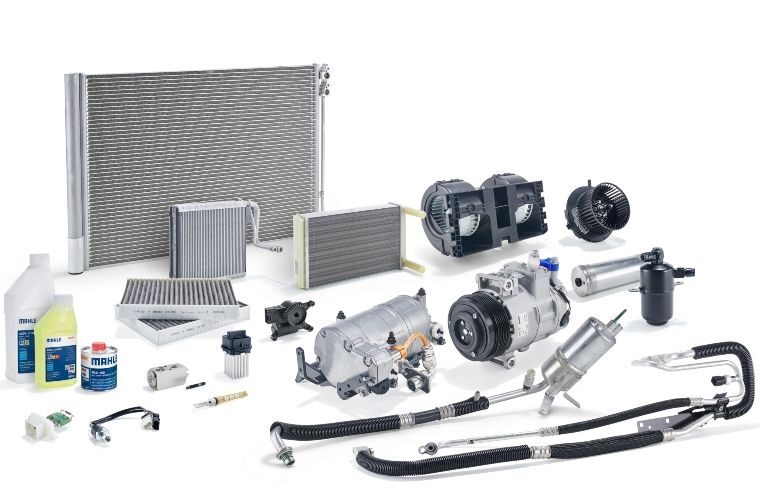When it comes to electric vehicles, controlling the hot and cold currents is the key to optimizing performance, cruising range, and service life.
MAHLE has already developed numerous innovations for the thermal soaking of batteries in electric vehicles and plug-in hybrids.
As of this year, with the acquisition of Behr Hella Service, MAHLE offers workshops a worry-free package for thermal management for all types of drive.
MAHLE is also committed to developing alternative drive systems, power electronics, and electric auxiliaries for every vehicle type – from passenger cars and commercial vehicles through machinery to e-scooters.
In short, if it says “e-mobility” on the outside, it has MAHLE on the inside.
At the beginning of 2019, the number of electric cars worldwide had risen to 5.6 million.
This represented an increase of 64 percent compared with the previous year.
If this trend continues, we’ll be seeing an enormous number of hybrids and electric cars in workshops in ten years’ time.
One thing is already certain: Thermal management will play a vital role and this is an area where MAHLE can provide optimal support.
Thermal management explained
The key components for high voltage thermal systems in electric vehicles include the battery cooler.
Battery segments and cooling plates form a permanently fixed module.
Coolant flows through the cooling plates and if the cooling capacity is insufficient because of high outside temperatures, for example, the coolant temperature is further reduced via the chiller.
Here’s how it works: the coolant flowing through the battery’s cooling plates is cooled down further in the chiller as the refrigerant from the air-conditioning system, which also flows through the chiller, evaporates.
Thanks to the electrically driven e-compressor, the air-conditioning can operate even when the engine is switched off.
The coolant temperature for the electric motor, battery, and power electronics is maintained at below 60°C inside a separate cooling circuit using a low-temperature radiator.
Electric coolant pumps with integrated control are gradually activated depending on the cooling capacity required.
They can be used as main, minor, or circulation pumps and operate independently of the engine.
When temperatures become too low, the coolant is heated via an electric auxiliary high-voltage heater.
This is integrated in the cooling circuit.
The electric drive of a hybrid or electric vehicle is designed for peak performance.
Consequently, they require high-voltage systems with voltages from 30 to 1,000 VAC or 60 to 1,500 VDC.
This makes the correct temperature control of the system and the individual components all the more important.
The temperature of the electric motor and power electronics must be kept below 60°C and the battery temperature between 15°C and 30°C.
This means that additional heating is needed in winter to keep the battery warm, whereas cooling is required in summer.
Cooling is also needed while the battery is charging and discharging.
The electric motor and power electronics must also be cooled.
And don’t forget that the passenger cabin needs to be heated in winter and air conditioned in summer.
This calls for a sophisticated system.
The refrigerant-based system, also known as direct battery cooling, is primarily found in hybrid vehicles.
The main components are the condenser, evaporator, and battery unit, consisting of battery cells, a cooling plate, and an electric auxiliary heater.
The system is supplied fully by the refrigerant circuit of the air-conditioning system and controlled separately via valves and temperature sensors.
Purely electric cars with high-performance batteries require more elaborate thermal management.
The coolant- and refrigerant-based system, also called indirect battery cooling, has three circuits.
Two of these have a low-temperature radiator, a coolant pump, a thermostat, and a coolant shut-off valve.
The third circuit is a conventional air conditioning system.
If outside temperatures are low, a high-voltage coolant heater warms the battery.
When temperatures become too high, it is cooled via a low temperature radiator.
The coolant temperature for the electric motor and the power electronics is maintained at below 60°C inside a separate circuit (inner, mid-blue circuit) using a low-temperature radiator.
If the outside temperatures are particularly high, the air conditioning system provides extra cooling for the battery.
Here, the refrigerant of the air conditioning system flows through an additional heat exchanger, the chiller, and further cools down the coolant, which also flows through the chiller.
The system is controlled with thermostats, sensors, pumps, and valves.
The air conditioning system actively supports the battery cooling.
That’s why the air conditioning check will play an even more important role in the future.







